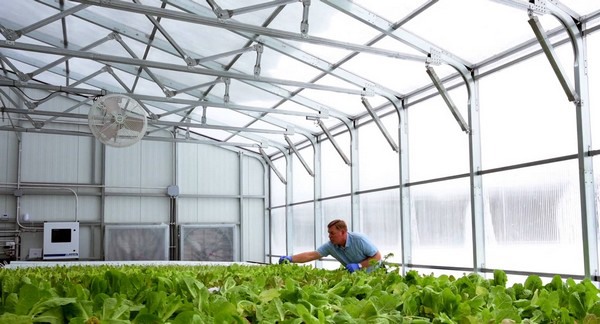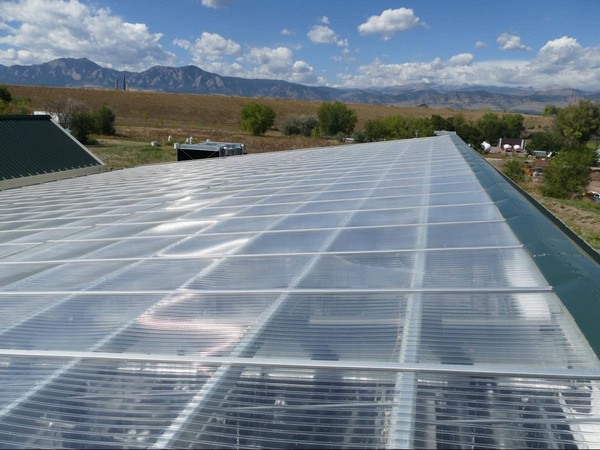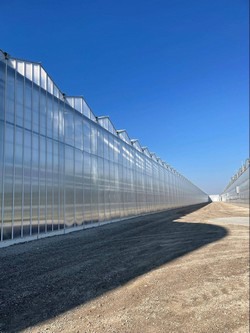Operators must carefully balance material cost, longevity, insulation, and light transmission rates to ensure a profitable and efficient controlled-environment agriculture operation.
Greenhouse operators have more information–and more to consider–than ever when installing new coverings. From materials and light transmission to insulation and shading needs, running a profitable and efficient operation starts with the right choice of building envelope.
Here, greenhouse experts and current operators offer their insights into the factors operators must weigh when making a greenhouse covering purchase.

Material cost and longevity
Greenhouse envelopes come in a wide array of materials. Commercial operators typically will employ glass, polycarbonate, or acrylic coverings. Budget can greatly dictate the choice of material that an operator will select for their facility, as siding costs can rapidly stack up.
Polycarbonate sidings will typically have the lowest cost per square foot (~$1.50 for a double wall, 4mm siding) but also the shortest expected lifespan—only 10 to 15 years. That said, a thick, 5-wall, 25mm polycarbonate siding can cost up to $8 per square foot, according to RII's Facility Design & Construction Best Practices Guide.
"I call polycarbonate the 'Toyota of glazings," Josh Holleb, Systems Integration Specialist at Ceres Greenhouse Solutions, says. "It's just super versatile. It's not fast, it's not sexy, but it does what it's supposed to." By comparison, single-pane glass coverings can be twice as expensive as polycarbonate but can last up to 30 years. Costs go up to $6 per square foot for double-paned glass.

"Glass is also heavy, so the structure changes," Holleb says, which can increase costs. "The glass also has to be treated appropriately with a film to avoid it shattering in case of breaks," he adds.
Acrylic bridges the gap at an average cost of $2.66 per square foot, with expected use extending from 15 to 30 years, depending on location and maintenance. "Acrylic is high-performance, UV-transmissive," Holleb says. "But… there's a fragility to it, so it matters what you're growing."
It should also be noted that acrylic is also more flammable than most other materials, so any combustion heaters or generators will have to be spaced appropriately away. For larger operations, designers and operators can consider using glass in their central corridor to create a fire break.
Light transmission 
One of the reasons a greenhouse operator would sacrifice durability or longevity is light transmission. A single-layer acrylic covering can have a light transmission rate of up to 90%, which would make it a good option for fruiting plant growers.
Crop choice directly impacts light transmission needs for your greenhouse operation. "Leafy greens are relatively low-light, low-temperature crops. They need about 17 moles per square meter per day" of light, Tony Barendregt, Senior Sales Representative for greenhouse manufacturer Prospiant, says. "A tomato is a (high) light … crop, just like cucumbers, and you're looking to achieve somewhere around 25 to 30 moles per square meter per day."
While their cost generally is a fraction of glass or acrylic, polycarbonate materials typically have lower light transmission levels. Having more layers increases insulation rates but also will drastically drop light transmission levels. For example, a 4mm polycarbonate double wall siding has an expected light transmission rate of 83%, while a 25 mm, the five-wall envelope has an expected rate of only 60%.
Barendregt suggests operators lean toward having an envelope with higher light transmission. By doing so, "in the winter time, you're ensured that you have the maximum light and have to work with less supplemental light," which reduces energy usage. In this regard, glass and acrylic envelopes are best.
To further reduce the amount of time supplemental lighting might be needed, Barendregt suggests glass coverings have an anti-reflective coating that will help "bring in outside light under more angles of the sun, so when the sun is low, the light still is going to be angled into the greenhouse through the glass." This coating essentially increases the amount of usable light reaching greenhouse crops throughout the day.
Shading and blackout curtains
Maximizing the use of natural light is a great way to improve greenhouse efficiency, but crop types and location can necessitate the use of shading and/or blackout curtains.
"The rule of thumb for most growers is 1% more light means 1% more production. And that is not always the best thing," Barendregt says. "If you have greenhouses in the South, maybe the crop gets too much light, and at that point, curtains might come into play to create the amount of shade" to optimize production. Curtains designed for light diffusion can also improve light penetration into the lower canopy while reducing overall heat load, further improving operational efficiency and performance.
"We also use the light deprivation curtain to hold the light in," Holleb says. "If you are growing lettuce that needs 18 hours [of light], but you are in an urban area with neighbors, you can't light the joint up at 8:00 PM in the middle of the winter. So the light deprivation curtain isn't keeping light out. It's making it look dark from the outside to meet code or appease neighbors."
Insulation
That same curtain, Holleb adds, increases the greenhouse's insulation value. Insulation is rated using metrics called U-value and R-factor. The U-value indicates thermal transmission–the higher the U-value, the more heat passes through the covering and into or out of the structure. The R-factor is the inverse of the U-value and indicates thermal resistance. A higher R-factor means the covering is best at separating inside and outside temperatures.
"A greenhouse with a single pane glazing [equipped with] a blackout curtain can get to R-2 or just over in the winter, which is the same as a double pane acrylic or close to a triple layer polycarbonate," Holleb explains.
As a general rule, a single layer of any material will have higher light transmission performance but will have less insulation value. A single-layer glass covering might have a 93% light transmission rate but will also be taking in a lot of heat during the day and losing a lot of heat at night. Daytime heat can be exhausted through vents, but nighttime heating typically will require additional HVAC equipment.
According to RII's Facility Design & Construction Best Practices Guide, it "is important that the envelope design considers not only the U-factor of individual materials but the overall assembly performance, which accounts for thermal bridging through high-conductivity materials (e.g., metal framing)." A greenhouse operator's choice of covering will influence their choice of framing materials, which in turn can have an impact on a greenhouse's insulation rate, Barendregt notes.
"Commonly, greenhouses are built with galvanized posts," he says. That galvanized post retains heat from the sun, which can cause nearby leafy green crops to stretch. In that case, he continues, it would be ideal to have a powder-coated structure.
For more information:
Resource Innovation Center
www.resourceinnovation.org
